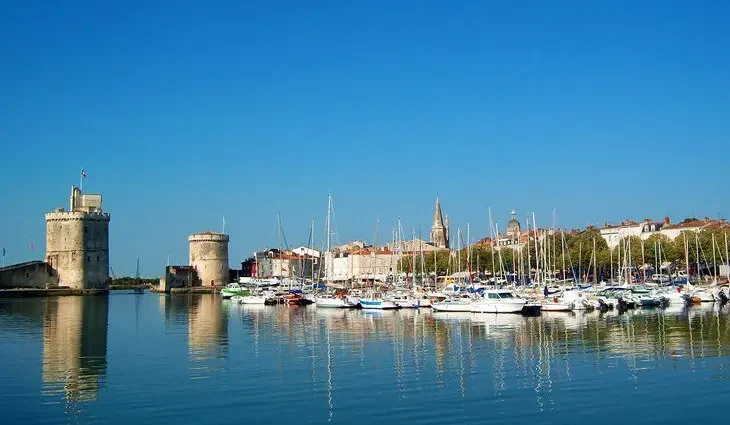Contents
- 1. La Rochelle
- 2. Poitiers
- 3. Angoulême
- 4. Rochefort-sur-Mer
- 5. Saintes
- 6. Royan
- 7. Château de La Rochefoucauld
- 8. Ile de Ré
- 9. Marais Poitevin
- 10. Ile d’Oléron
- 11. Cognac
- 12. Château d’Oiron
- 13. Niort
- 14. Château de Mirambeau
- 15. Parc du Futuroscope (Amusement Park)
- 16. Les Lacs de Haute-Charente (Lake District)
- 17. Saint-Savin-sur-Gartempe
- 18. Les Jardins du Chaigne
- Beautiful Villages in Poitou-Charentes
- 19. Angles-sur-l’Anglin
- 20. Verteuil-sur-Charente
- 21. Aubeterre-sur-Dronne
- 22. Chauvigny
- 23. Brouage
- 24. Coulon
- 25. Melle
- 26. Talmont-sur-Gironde
- 27. Aulnay
- 28. Mornac-sur-Seudre
- Where to Stay in Poitou-Charentes for Sightseeing
The Poitou-Charentes region is a relatively undiscovered corner of France, with ancient seafaring ports hugging the Atlantic’s rugged coastline, and quaint medieval towns nestled on hilltops, along gently flowing rivers, and in enchanting marshlands.
The area overlaps with a portion of the Camino de Santiago, a medieval pilgrimage trail leading to Santiago de Compostela in Spain. An abundance of exquisite Romanesque churches are a legacy of this heritage.
In addition to cultural attractions, natural wonders abound. Spectacular sandy beaches extend for miles along the Côte de Beauté (Coast of Beauty), and idyllic island getaways are within easy reach.
Poitou-Charentes is also renowned for its cuisine, including seafood stew, and locally raised Barbezieux chicken.
Plan a fabulous travel itinerary and discover the best places to visit in this picturesque region with our list of the top attractions and beautiful villages in Poitou-Charentes.
1. La Rochelle
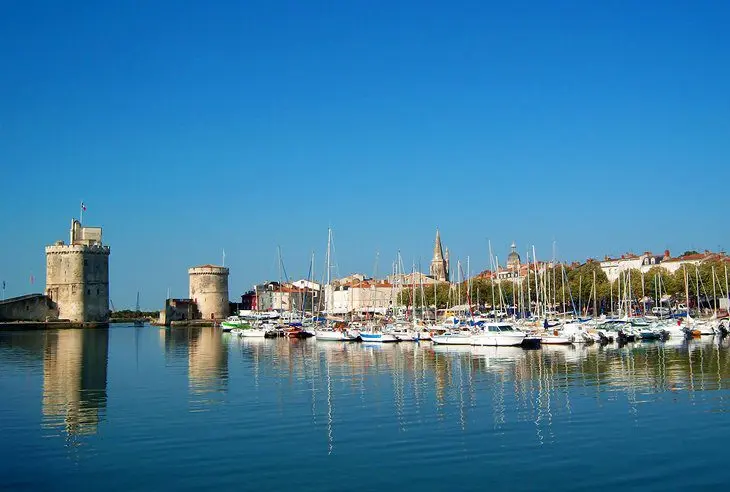
Sheltered in a bay of the Atlantic Ocean, La Rochelle is an atmospheric seafaring port that dates back to the medieval era. The Vieux Port (Old Port) is guarded by two massive towers, the Tour Saint-Nicolas and the Tour de la Chaîne, which served defensive purposes during the Middle Ages.
The Old Port has a bustling harbor with many restaurants and outdoor cafés, especially at the Cours des Dames and the Quai du Gabut.
Nearby is the Bassin à Flot, an atmospheric fishermen’s quarter. At the Old Port, tourists can embark on a cruise or charter yacht ride to the Île de Ré (one hour away) and the Île d’Oléron (50 minutes away).
Tourists will enjoy exploring the Old Town of La Rochelle, with its narrow pedestrian streets and stately historic landmarks. At the center of town, the Hôtel-de-Ville (Town Hall) exemplifies Flamboyant Gothic architecture.
The arcaded Rue des Merciers, true to its name “Street of the Haberdashers,” is lined with many stylish clothing and shoe boutiques, found in the arcaded corridors.
Other must-see sights include the Aquarium, the Musée Maritime (Museum of Seafaring), and the emblematic Tour de la Lanterne lighthouse.
Accommodation: Where to Stay in La Rochelle
2. Poitiers

The old capital city of the Poitou region, Poitiers is most famous for defending Christianity in the 8th century, when Charles Martel halted the advance of Islam. Remarkable historic churches are testimony to the town’s Christian heritage.
A designated UNESCO site, the 11th-century Romanesque Eglise Saint-Hilaire-le-Grand dazzles visitors with its six domed chapels built around the central apse and transept.
Nearby is the 12th-century Eglise Notre-Dame-la-Grande, considered one of the most exquisite Romanesque churches in France. The richly decorated facade features Byzantine-influenced details of the Biblical scenes.
Continuing towards the river, tourists will come across the Cathédrale Saint-Pierre, noteworthy for its 13th-century stained-glass windows.
Just a few steps away from the cathedral is the Baptistère Saint-Jean, the oldest surviving Christian monument in France, dating to the 4th century. The church contains Merovingian sarcophagi and Romanesque frescoes.
Near the river, the Eglise Sainte-Radegonde, is dedicated to Saint Radegonde, the Merovingian queen who became a nun and founded a monastery. Not to be missed are the ambulatory’s ornately carved Romanesque capitals, adorned with figures of people and animals.

3. Angoulême

Angoulême has endured a tempestuous history despite its lofty position high above the Charente River, seemingly far from the troubles of the world. The town’s ramparts afford panoramic views of the countryside, but these medieval walls were necessary to defend the city. Still the Wars of Religion left the town severely damaged.
The 12th-century Cathédrale Saint-Pierre (renovated in the 19th century) is a masterpiece of Romanesque art. Truly incredible in its craftsmanship, the cathedral’s intricately carved facade depicts Ascension and Last Judgment scenes, with more than 70 figures. The interior features harmonious classical columns and four domes that offer a sense of spaciousness.

Other highlights include the Hôtel de Ville (Town Hall) built in 1858-1869 on the site of a Château of the Dukes of Angoulême. The only surviving remnants of the castle are the Tour Polygone (13th-century tower) and the Tour de Valois (15th-century tower).
Nearby is the Eglise Saint-André, an interesting blend of architectural styles: a 12th-century Romanesque nave, Gothic chapels added in the 15th century, and a Neoclassical facade.
Housed in the former Bishop’s Palace, the Musée d’Angoulême offers three diverse collections: archaeology (prehistoric to medieval); fine arts; and art of the Maghreb, Africa, and Polynesia.
Angoulême hosts a well-attended International Comic Strip Festival every January.
4. Rochefort-sur-Mer
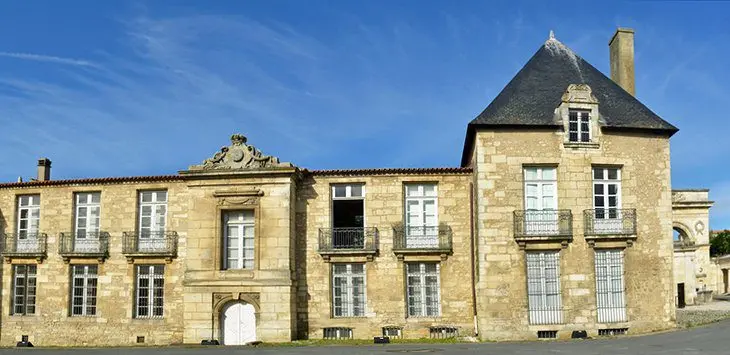
Listed as a Ville d’Art et d’Histoire (City of Art and History), Rochefort-sur-Mer was built up in 1666 as a naval port at the request of King Louis XIV. The town’s maritime heritage is on display at the 17th-century Arsenal de Rochefort (military arsenal) and Corderie Royale (the old royal ropeworks building).
The Musée National de la Marine also educates visitors about local seafaring history. Housed in a 12th-century church (the town’s oldest building), the Musée Archéologique de la Vieille Paroisse has a collection of archaeological finds from the Bronze Age through the Paleo-Christian era.
Today Rochefort-sur-Mer is one of the top spa destinations in France, The town has two excellent spas that offer thermal baths with therapeutic health benefits: Les Thermes de Rochefort, a sleek modern facility, and in a stately historic building, La Maison du Curiste.
About 25 kilometers away is the Plage de Marennes, an expansive sandy beach popular with French families because it’s safe for swimming and bathing. Situated in an estuary and surrounded by sand dunes, the calm waters are protected from waves and tides. Children can wade in the shallow areas; lifeguards survey the scene during high season. There’s also a playground and a café.
5. Saintes
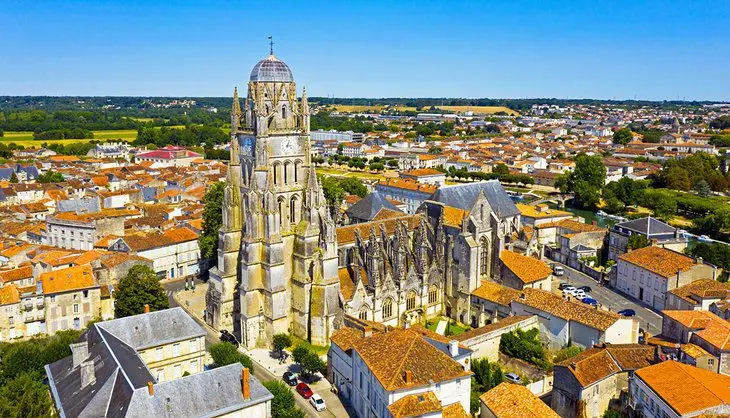
Saintes has a rich heritage reflected by its ancient monuments. Landmarks from the 1st-century AD include the Arch of Germanicus and the Amphitheatre that once seated 20,000 spectators.
Three Romanesque churches reveal the town’s early medieval history: the 11th-century Abbaye aux Dames with an elaborately sculpted facade; the austere 12th-13th-century Eglise Saint-Pallais; and the UNESCO-listed Eglise Saint-Eutrope, which has a meditative spiritual ambience and is one of Europe’s largest crypts. The Eglise Saint-Eutrope was founded in 1096 for pilgrims on the “Camino de Santiago.”
The Abbaye aux Dames is now home to La Cité Musicale, a center that offers experiences for visitors to learn about music. There is also a boutique and an outdoor café. Every year in July, the center hosts a classical music festival, the Festival de Saintes, which takes place over eight days and includes more than 30 concerts.
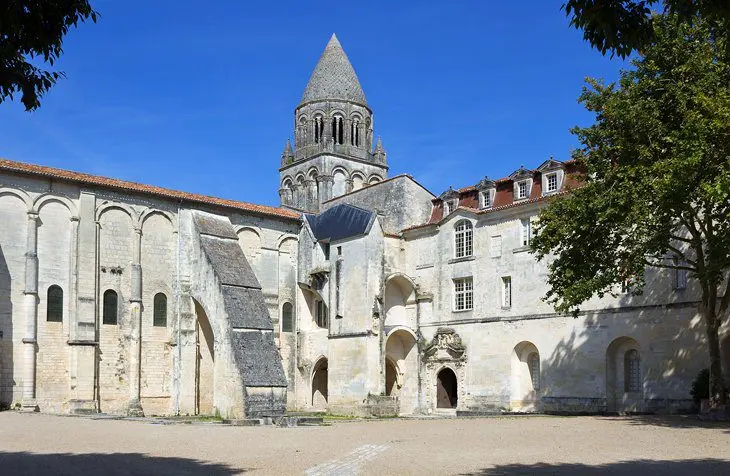
For more insight into the town’s culture, tourists can visit several museums. The Musée Archéologique displays a large collection of Gallo-Roman archaeological objects, while the Musée Dupuy-Mestreau presents works of art from the region (paintings, furniture, faïence ceramics, costumes, jewelry, and everyday objects) in the elegant rooms of an 18th-century mansion.
In the former Hôtel de Ville (Town Hall) of Saintes, the Musée de l’Échevinage (Museum of Fine Arts) displays a collection of sculptures, ceramics, (including Sèvres porcelain), historical paintings, and landscape paintings. Highlights of the collection are the Allégorie de la Terre by the Dutch master Jan Brueghel de Velours and Mars et Vénus by the Flemish painter Gillis Coignet.
Saintes is also renowned for the Jeux Santons, an international festival of folkloric music and dance that takes place annually in July.
6. Royan
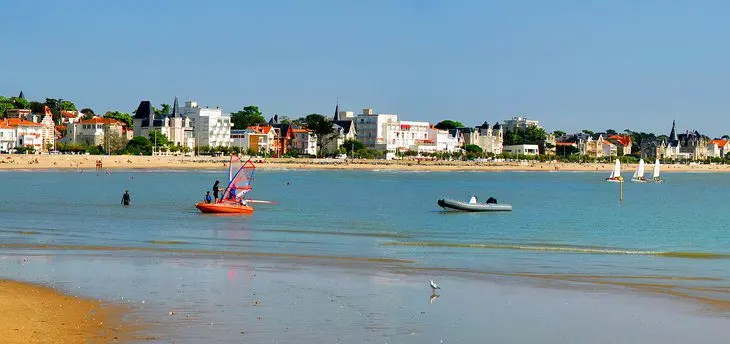
The sunny seaside resort of Royan is the most popular vacation destination along the “Côte de Beauté” (Coast of Beauty), which extends from the Gironde Estuary to the Avert Peninsula. Royan’s sandy shoreline draws many sunbathers and water sports enthusiasts during summertime.
The largest beach of Royan, the Plage de la Grande Conche extends for nearly three kilometers. This sheltered fine-sand beach has a swimming pool, volleyball nets, public toilets and showers, and lounge chair rentals. A wide selection of waterfront restaurants, cafés, and shops makes it easy to enjoy a full day of sunbathing, relaxation, and recreation. Families appreciate the calm waters and lifeguard surveillance.
Although much of Royan was destroyed during the Second World War, the Pontaillac Quarter was spared. This fashionable neighborhood has retained the charm of a bygone era, seen in its Belle Epoque oceanfront villas and traditional fishing cabins.
Another top tourist attraction is the Sentier des Douaniers coastal path, which affords stunning views of the Phare de Cordouan lighthouse.
For families with kids, one of the best places to visit is the Zoo de La Palmyre (about 15 kilometers away from Royan). Tucked away in an 18-hectare pine forest, the zoo is home to over 100 animal species, from flamingos and hippos to lions and gorillas.
Other favorite family-friendly destinations on the Côte de Beauté include the wide, sheltered beach at Saint-Georges-de-Didonne, the sandy beaches and campsites at Meschers-sur-Gironde, as well as Saint-Palais-sur-Mer.
7. Château de La Rochefoucauld

The owners of this castle, the Rochefoucauld family, are one of the five oldest noble families in France and can trace their aristocratic lineage back to the year 1019.
Reminiscent of a Loire Valley castle, the Château de La Rochefoucauld creates a grand impression with its turreted medieval towers and lavish Renaissance galleries. The castle’s magnificent Italian-influenced Cour d’Honneur is one of the finest courtyards in France.
The Château de La Rochefoucauld includes bed-and-breakfast accommodations; there are two guest suites (chambres d’hôtes) in the castle’s 18th-century wing. The castle is also available as a wedding venue.
Address: Château de La Rochefoucauld, 16110 La Rochefoucauld
Official site: http://www.chateau-la-rochefoucauld.com/
8. Ile de Ré
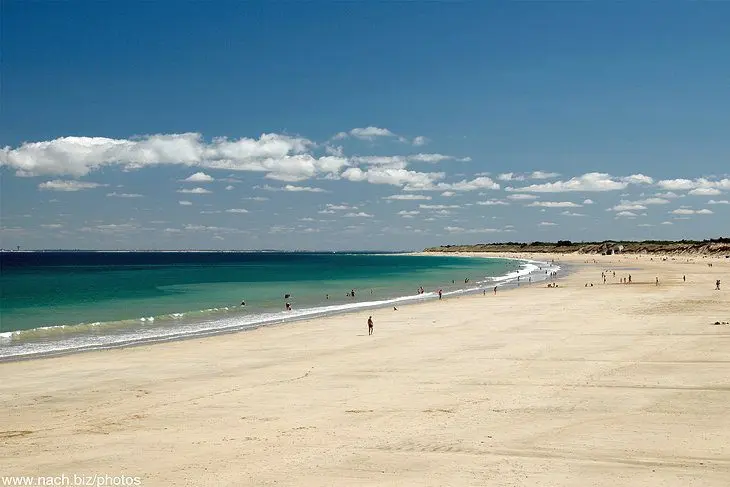
Appreciated for its natural scenery and balmy climate, the Ile de Ré offers tourists a truly relaxing getaway. This idyllic island attracts many visitors during the summer yet still has a remote feeling.
The island offers 10 kilometers of pristine sandy beaches and a wild terrain of pine forests, marshes, oyster beds, hollyhocks, and fields of rosemary.
The Ile de Ré is a paradise for sports enthusiasts; sailing, surfing, and cycling are popular activities. The UNESCO-listed village of Saint Martin-de-Ré has everything on tourists’ wish lists: a quaint ambience, lively fishing harbor, stylish boutiques, trendy cafés, and gourmet restaurants.
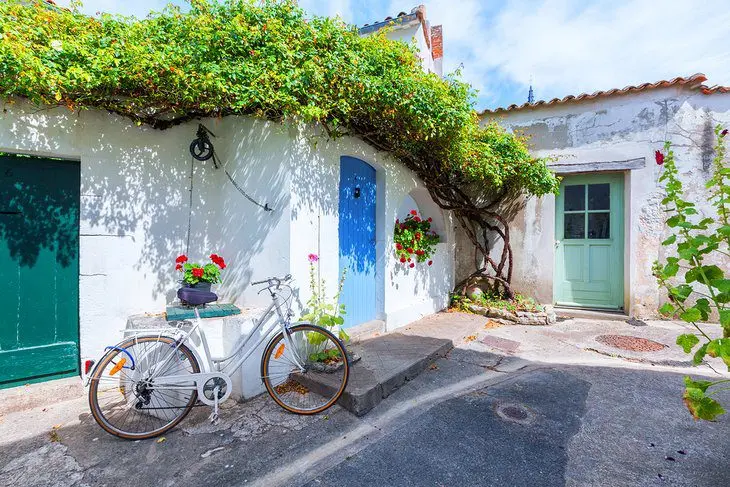
Ile de Ré has two villages designated on the list of Les Plus Beaux Villages de France (The Most Beautiful Villages of France): the seaside village of Ars-en-Ré, which has medieval cobblestone streets, lovely whitewashed houses, a picturesque port, sandy beach, and a Romanesque-Gothic church; and the village of La Flotte, which delights with its attractive fishing port, waterfront restaurants, and evocative ruins of a 12th-century Cistercian abbey.
The best beaches on the Ile de Ré are Le-Bois-Plage-en-Ré, with its expansive sandy shoreline, and the pine forest-fringed La Conche des Baleines, which is a great place for swimming.
The Ile de Ré is a 30-minute drive from La Rochelle; the island is connected to the mainland by a three-kilometer bridge.
9. Marais Poitevin
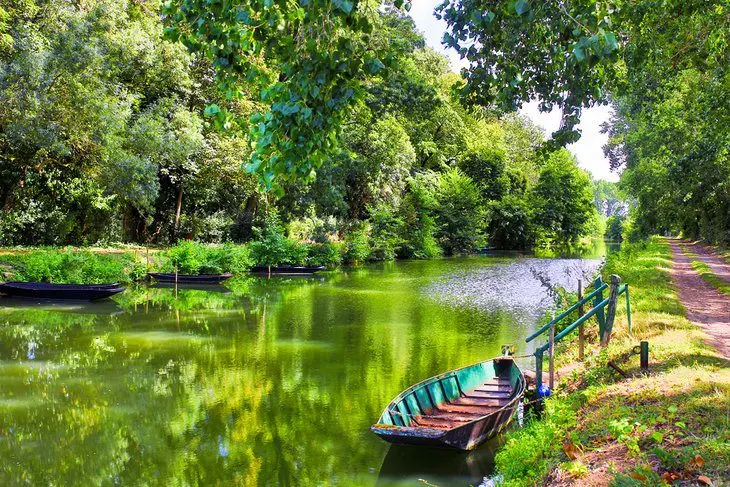
Until the 11th century, the Marais Poitevin was part of the Gulf of Poitou. As a result of man-made canals, the area developed into an enchanting marshland now known as “Venise Verte” (“Green Venice”). This peaceful 15,000-hectare nature reserve has a dreamy quality and is best discovered by taking a ride on a flat-bottomed boat (barque) through the meandering streams and waterways.
The surrounding landscape is a patchwork of pastoral fields, leafy poplar trees, and lush meadows. A bicycle path runs along the river between the villages of La Garette and Le Mazeau, allowing cyclists to admire the verdant scenery and typical Marais houses.
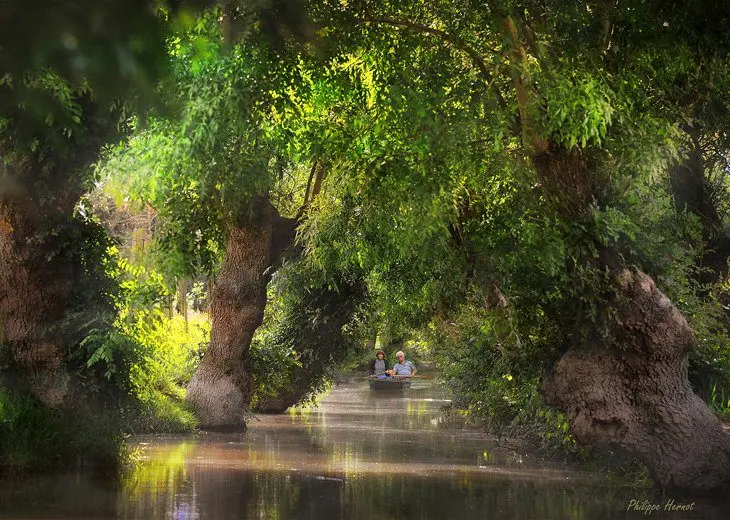
Coulon is the main community of the Marais Poitevin. This alluring village has a noteworthy 11th-century church and blue-shuttered waterfront houses.
Other highlights of the area include Arçais, with its charming old fishing port; Magné, which has a gourmet restaurant (the Brasserie de la Repentie) that serves specialties of the Marais area; the small hamlet of Saint-Hilaire-la-Palud; and the villages on the Sèvre River in the area around Niort.
10. Ile d’Oléron
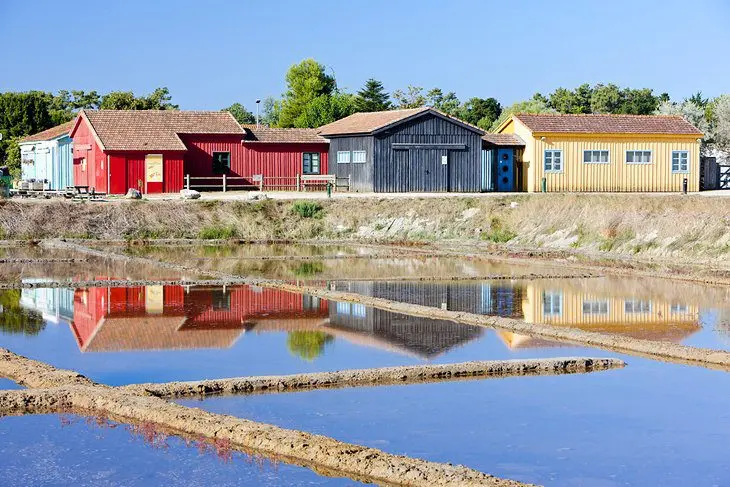
A favorite summertime holiday destination, the Ile d’Oléron is popular because of its beautiful beaches and unspoiled nature sites. The island is easily accessible by ferry, as well as by train or car (it’s connected with the mainland by a viaduct).
The island’s most important town is Le Château-d’Oléron, which has a 17th-century citadel and a historic oyster port that displays art exhibits in former oyster farmers’ huts. On Sundays, the town hosts a large and well-attended market at its covered hall. Numerous stalls sell local specialties such as fresh-caught fish, fruits, vegetables, bread, and pastries.
In the village of Saint-Pierre d’Oléron, the Musée de l’île d’Oléron is devoted to the history and folk art of the island. Visitors learn about the island’s traditional occupations: oyster farming, salt harvesting, and fishing. Exhibits include historical costumes and everyday objects.
The Ile d’Oléron boasts splendid beaches on its 100-kilometer coastline, and there is something for everyone. Water sports enthusiasts head to the Vert-Bois and Grande Plage beaches, and surfers in particular like the challenge of the waves at the Plage de la Giraudière and the Plage des Huttes.
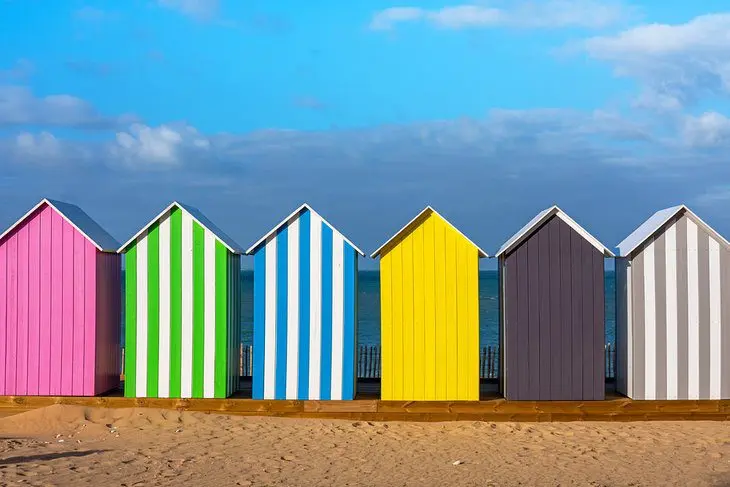
Families prefer the beaches of La Brée les Bains and Saumonards in Boyardville (on the east coast of the island) because they have gentler waves.
A long stretch of sandy beaches (including the Grande Plage) is found on the west side of the island near La Cotinière, a small fishing village with colorful boats docked at its harbor. The Office of Tourism organizes visits to the famous fish auction of La Cotinière. Another way to discover the village is by wandering the narrow pedestrian streets, stopping to admire the blue or green-shuttered whitewashed houses and relax at outdoor cafés.
Also on the east side of the island are extensive oyster beds. Every year in August, the island celebrates its fishing heritage and local gastronomy with the Fête du Chenal d’Ors.
11. Cognac
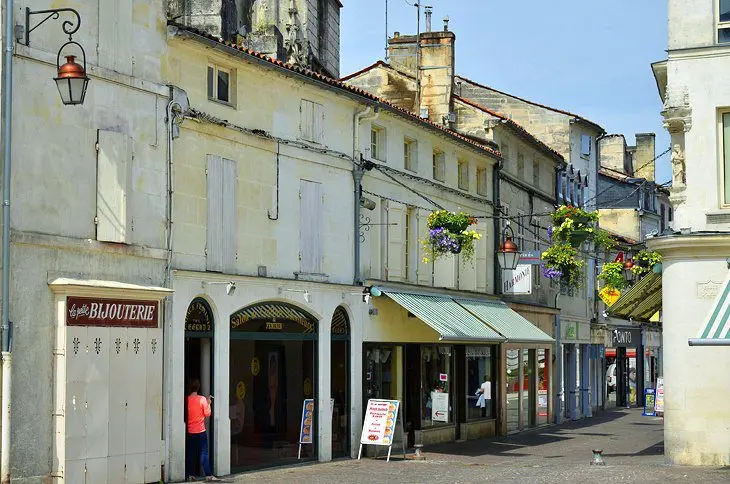
Listed as a “Ville d’Art et d’Histoire,” Cognac has a sense of elegance to match its location on the slowly flowing Charente River. Visitors enjoy strolling along the riverside promenade, which is graced by stately mansions. Near the Pont Neuf bridge, the Château de Cognac is a grandiose Historical Monument, which dates to the 10th century.
A few steps away from the castle is the Porte Sainte-Jacques, the entrance to the medieval Old Town, a maze of cobblestone streets lined with white-shuttered stone buildings. At the heart of the Old Town, the Eglise Saint-Léger has a simple Romanesque facade and a luminous Gothic sanctuary.
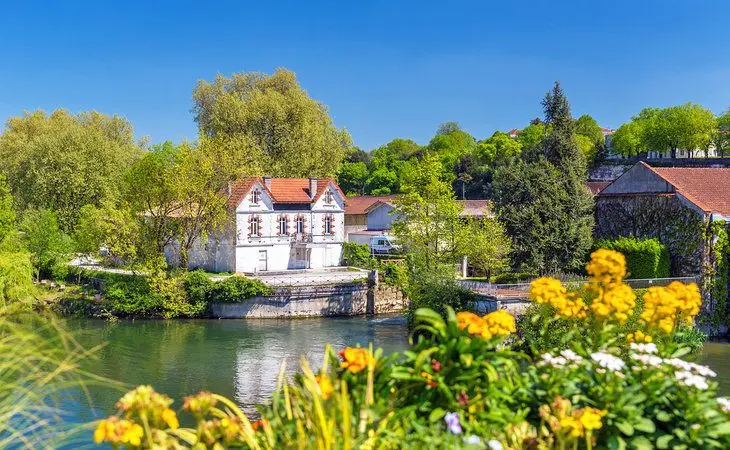
The countryside around Cognac has scenic nature trails for hiking or biking excursions. Several attractions are also within easy driving distance of Cognac: the village of Châteauneuf-sur-Charente (27 kilometers away), with its lovely Romanesque church, and the Château de Crazannes (45 kilometers away), a Historical Monument built in the 14th and 15th centuries that awes visitors with its dazzling Gothic architecture and storybook setting.
Surrounded by eight hectares of luxuriant grounds, the Château de Crazannes is open to the public for visits, as well as guided tours. The château also welcomes visitors to admire its garden, 11th-century Romanesque chapel, and museum (for an admission fee). Overnight bed-and-breakfast accommodations are available at the château.
Touristic boat rides along the Charente River begin in the little village of Saint-Simon (30 kilometers away).
12. Château d’Oiron
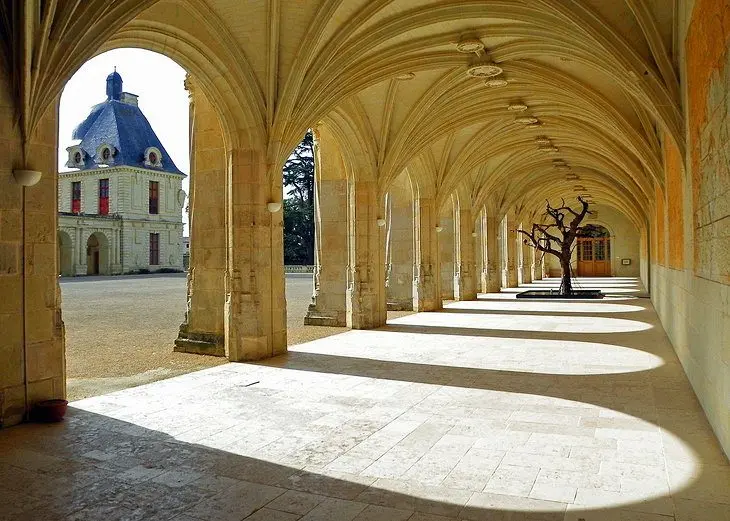
This majestic Renaissance château was once the residence of Claude Gouffier, who was the model for the Marquis de Carabas character in Charles Perrault’s children’s story, Puss in Boots.
The château’s Grande Galerie displays beautiful 17th-century paintings in the style of the Ecole de Fontainebleau and the Galerie du Grand Ecuyer is adorned with 16th-century frescoes depicting scenes from Aeneid.
The castle also houses the Curios & Mirabilia contemporary art and curiosities collection, which includes many surprising and whimsical objects.
Address: 10 Rue du Château, 79100 Oiron
13. Niort
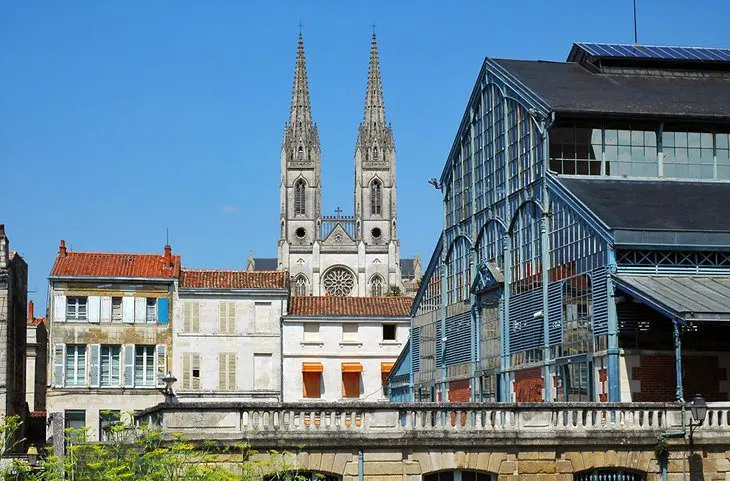
The Marais Poitevin’s most urban town, Niort is perched on two hilltops along the Sèvre Niortaise river. Henry II (King of England) and his wife Eleanor of Aquitaine built a castle in Niort in the 12th century; their son Richard “The Lion Heart” made later additions.
All that remains of that ancient castle is the twin-towered Donjon de Niort, which now houses an archaeological museum with artifacts from the Bronze Age through the medieval era.
Other cultural attractions are Le Pilori – Espace d’Arts Visuels, which presents exhibitions of contemporary art and the Musée Bernard d’Agesci, which displays fine arts and natural history collections.
14. Château de Mirambeau
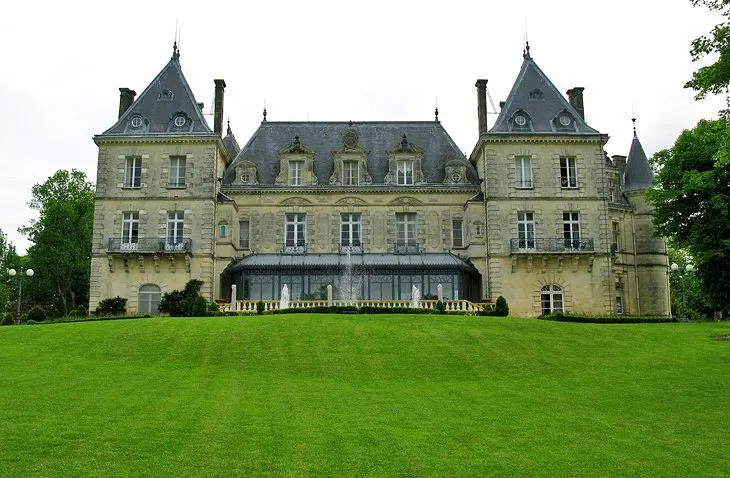
Less than an hour drive from Cognac, the Château de Mirambeau allows travelers to spend the night like the lord of a castle. A splendid example of Renaissance architecture, this refined castle has been converted into a luxurious five-star Relais & Châteaux hotel decorated in sumptuous style, ready to welcome guests seeking pampering accommodations.
The eight-hectare property has gorgeous gardens, two tennis courts, an outdoor swimming pool and indoor pool, fitness room, and an upscale spa with a Jacuzzi, Turkish baths, and Finnish sauna. The property includes a nature trail where guests may take a walk or go for a jog.
The hotel also has a fine-dining gastronomic restaurant, Les Deux Lévriers, that serves classic yet creative French cuisine based on ingredients from the local market.
Address: 1 Avenue des Comtes Duchâtel, 17150 Mirambeau
Official site: https://www.chateauxmirambeau.com/en/
15. Parc du Futuroscope (Amusement Park)
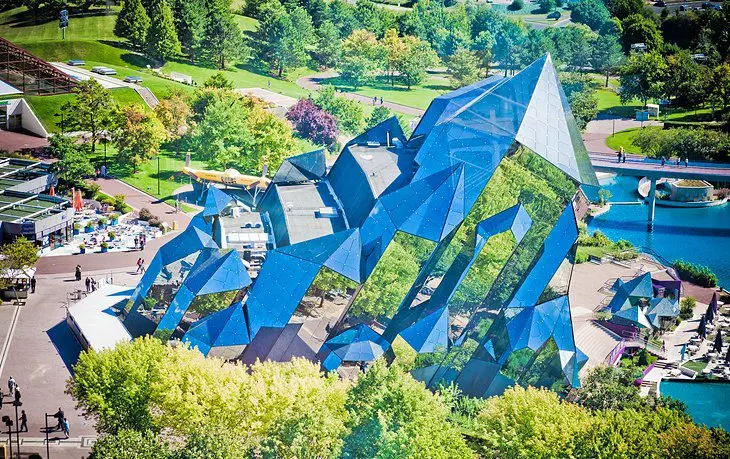
A fantastic destination for families with children, Futuroscope is a unique amusement park with a focus on imagining the future. This innovative theme park features thrilling rides such as Dances with Robots and the Sébastien Loeb Racing Xperience, and interactive entertainment like Ice Age and The Waterworks.
The Parc du Futuroscope (12 kilometers away from Poitiers) has many casual dining options (restaurants and take-away food), as well as an on-site accommodations at the Hôtel du Futuroscope, which is just a short walk from the theme park’s attractions. There are also many hotels to choose from nearby.
Address: Avenue René Monory, 86360 Chasseneuil-du-Poitou
Official site: https://en.futuroscope.com
16. Les Lacs de Haute-Charente (Lake District)
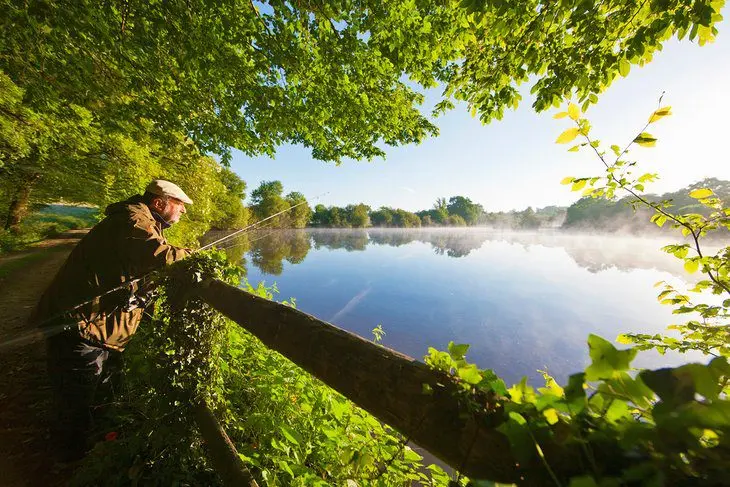
Nature lovers will enjoy an excursion to the Lake District of the Haute-Charente (Upper Charente district), a popular destination among French families. The pleasant bucolic scenery makes the Haute-Charente Lake District a wonderful spot for picnics and camping.
There are two large lakes ideal for boating and water skiing, as well as for swimming and relaxing by the water. The area is also a paradise for outdoor sports, including fishing and bird-watching.
Thrill seekers will want to visit the Adventure Park in Massignac, which offers ziplining, bungee jumping, and adventure courses.
17. Saint-Savin-sur-Gartempe
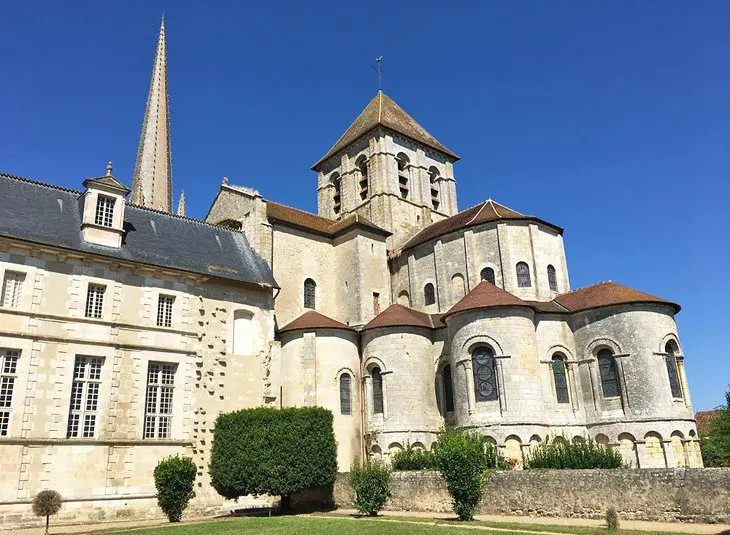
In the little town of Saint-Savin-sur-Gartempe is a remarkable abbey church that was founded during the Carolingian era.
The UNESCO-listed Abbaye de Saint-Savin is called the “Romanesque Sistine Chapel” because of its exceptional 11th- and 12th-century wall paintings. These Biblical-themed murals are some of the finest medieval paintings in France. The most noteworthy works, which depict Old Testament stories from the Creation onwards, are found on the vaulting of the nave.
A superb view of the abbey church can be seen from the Pont-Vieux (Old Bridge) on the Gartempe River.
18. Les Jardins du Chaigne
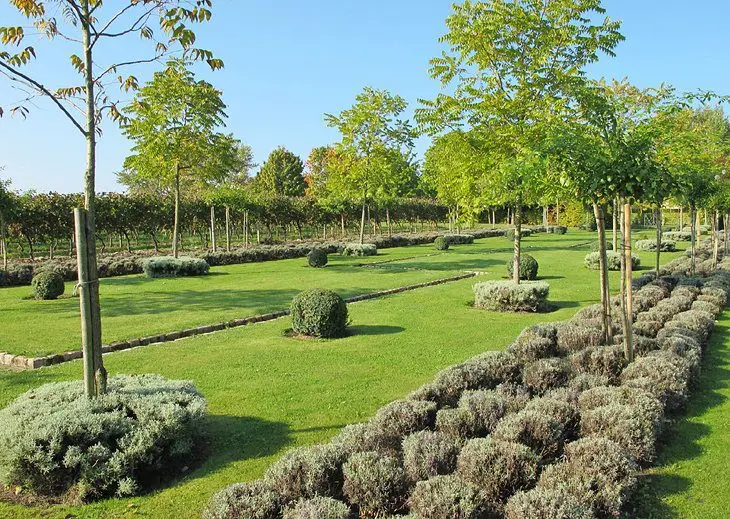
Nestled in a landscape of vine-covered rolling hills, Les Jardins du Chaigne is labeled as a “Jardin Remarquable” (Remarkable Garden). The garden offers an escape to a scene of serene natural beauty. Visitors are delighted by the variety of vibrant flowers, the fruit trees, and fragrant herbs.
The garden is divided into sections: a French garden with geometric hedging, well-groomed topiaries, lavender, and roses; an Italian-style garden with Mediterranean plants; the vegetable garden, with its selection of edible plants; the “Chemin d’Eau,” with decorative water channels; and the “Théâtre de Verdure,” an area of sloped lawn that mimics the shape of a theater.
The Jardins du Chaigne property is about 30 kilometers from Cognac and 35 kilometers from Angoulême, making it an easy and worthwhile excursion by car. The gardens are open to the public for visits from mid-April through September on Tuesday, Wednesday, Thursday, Friday, and Saturday.
Address: Le Chaigne, 16120 Bellevigne
Beautiful Villages in Poitou-Charentes
19. Angles-sur-l’Anglin
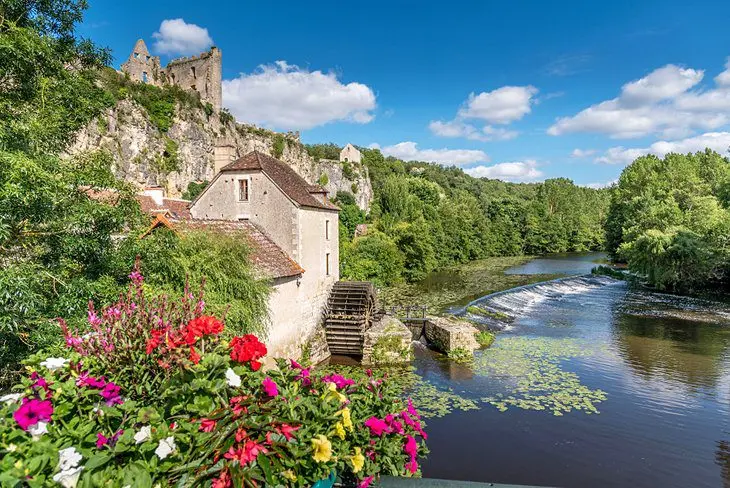
One of France’s Plus Beaux Villages, Angles-sur-l’Anglin has all the charm typical of a medieval French riverside town: quaint historic buildings, vibrant floral adornments, and a bucolic setting. The ruins of an ancient château stand on a rocky outcrop above the town, lending an air of old-world romance.
Visitors will enjoy wandering the cobblestone streets and shopping at antique stores and artisan boutiques. The village is renowned for its traditional artisanal embroidery. The Maison des Jours d’Angles offers demonstrations of embroidery techniques and sells hand-embroidered items.
Just outside of the village is an amazing prehistoric site, the Roc-aux-Sorciers, which reveals engravings of bison, horses, lions, and other figures created by Cro-Magnon people 15,000 years ago.
20. Verteuil-sur-Charente

A fairy-tale castle crowns the picturesque village of Verteuil-sur-Charente, by the banks of the Charente River. Surrounded by a leafy park, the turreted Château de Verteuil is considered one of the finest castles in the Charente region. Because of its elegant architecture and sensational setting, the castle is often used as a venue for weddings and other events.
Near the castle (about a five-minute walk away), the town’s old mill at the riverside, the Moulin de Verteuil, has been converted into a restaurant and tea salon with an old-fashioned interior and outdoor seating at the water’s edge.
It’s also worth spending time exploring the village, walking along the riverside, shopping at the boutiques in the center of town, and wandering the atmospheric narrow alleyways.
The Ruelle du Prieuré leads up to the Eglise Saint-Médard, a Romanesque church that was on the medieval “Way of Saint James” pilgrimage route from Tours to Santiago de Compostela. The church contains the fantastic Mise au Tombeau sculpture created in the 16th century by Germain Pilon.
At the heart of the village, on an island in the Charente River, the 15th-century Le Couvent des Cordeliers monastery is now a luxury hotel with terraced gardens and an outdoor swimming pool.
21. Aubeterre-sur-Dronne

Another of France’s Plus Beaux Villages, Aubeterre-sur-Dronne is a medieval hilltop village with steep cobblestone streets and red-tile roofed buildings. During the Middle Ages, travelers arrived here on the pilgrimage trail to Santiago de Compostela in Spain.
For modern-day visitors, things to do include wandering the town to admire the views of the countryside, and shopping at artisan boutiques.
The village has two Romanesque churches: the Collégiale Saint-Jean, built in 1171, and the Eglise Saint-Jean, which was carved out of a cliff by 12th-century monks and contains a reliquary inspired by one discovered during the First Crusade at the Holy Sepulchre Church in Jerusalem.
22. Chauvigny
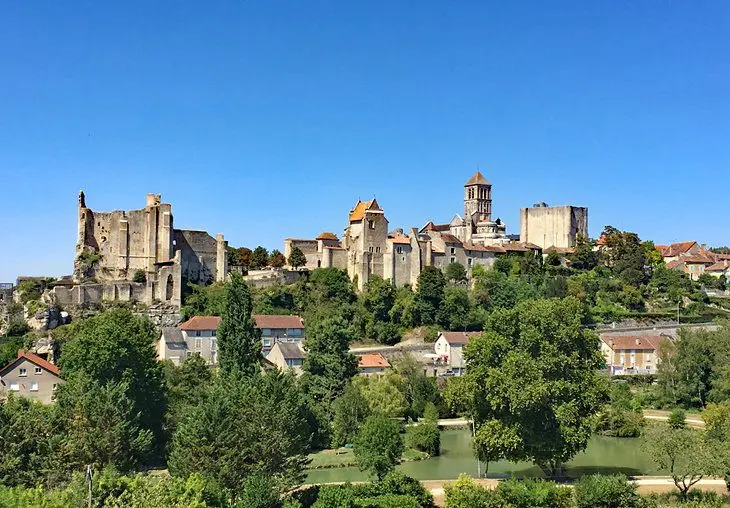
The upper portion of Chauvigny is built on a dramatic cliff that overlooks the gently flowing Vienne River. This medieval city is dominated by five castles; the Château d’Harcourt at the center of town is in the best condition. Built in the 12th and 13th centuries, this castle features formidable defense walls with turreted towers.
At the site of the ruined Château des Évêques, tourists can attend the Géants du Ciel (Giants of the Sky) show, where soaring falcons, eagles, great-horned owls, and other amazing birds demonstrate the ancient art of falconry.
The Château de Gouzon houses an archaeological collection within its donjon, the Espace d’Archéologie Industrielle du Donjon de Gouzon. This museum presents archaeological finds dating back to the Neolithic era and includes an interesting exposition about ancient Roman artifacts found at the Gué-de-Sciaux site about 20 kilometers outside of Chauvigny.
Also not-to-be-missed are the town’s Romanesque churches. The Collégiale Sainte-Pierre dazzles visitors with its abundantly embellished sanctuary, featuring ornate sculptural details.
The Saint-Pierre-des-Eglises chapel features Carolingian frescoes that are masterpieces of pre-Romanesque art.
23. Brouage
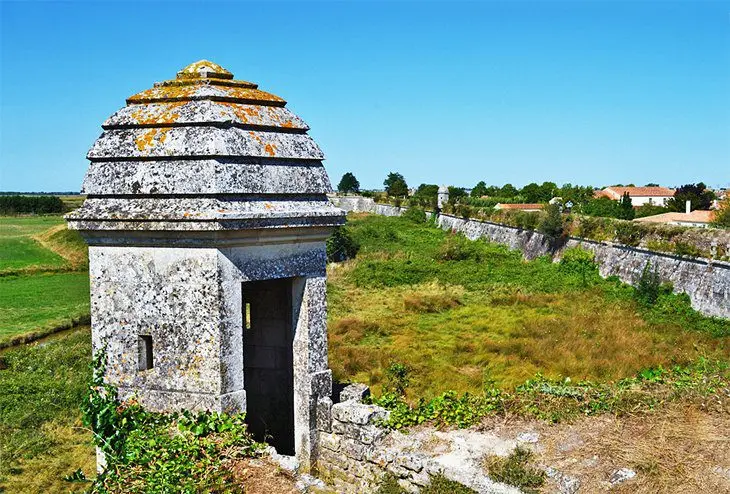
Listed as one of France’s Plus Beaux Villages, Brouage is surrounded by an expansive 3,000-hectare marshland. This serene countryside is dotted with oyster beds and interspersed with hiking trails that are ideal for nature walks and bird-watching.
The 17th-century Citadelle de Brouage encloses the town within more than two kilometers of 13-meter-high walls, and includes seven bastions. Visitors can walk along the old citadel’s ramparts to take in sensational views of the landscape.
The citadel’s Halle aux Vivres houses the Centre Européen d’Architecture Militaire, a museum devoted to the history of military architecture.
Tourists will also enjoy discovering the village’s locally owned artisan boutiques and ateliers of paintings, ceramics, and other crafts.
24. Coulon
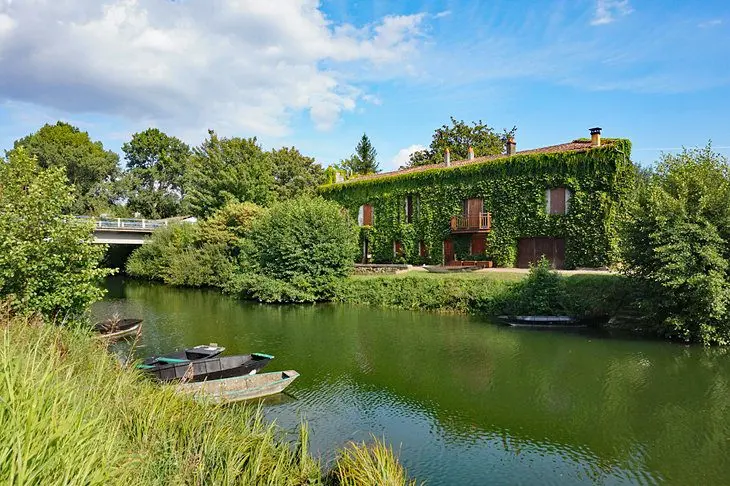
At the heart of the Marais Poitevin, also known as the Venise Verte (“Green Venice”), Coulon is an atmospheric village with whitewashed marshland houses featuring colorful shutters. Interlaced with tranquil canals, the village is the capital of the Marais Poitevin (96,000-hectares of marshland protected as a Natural Regional Park).
The Maison du Marais Poitevin celebrates the regional culture with exhibits about the marshland environment, rooms decorated in the typical Marais style, and a carpenter’s boat-making workshop.
During summertime, the Maison du Marais Poitevin offers guided tours by foot and boat. Local boatmen also lead tours through the marshland on traditional flat-bottomed boats. Alternatively, tourists can rent canoes to explore the waterways at their leisure.
25. Melle
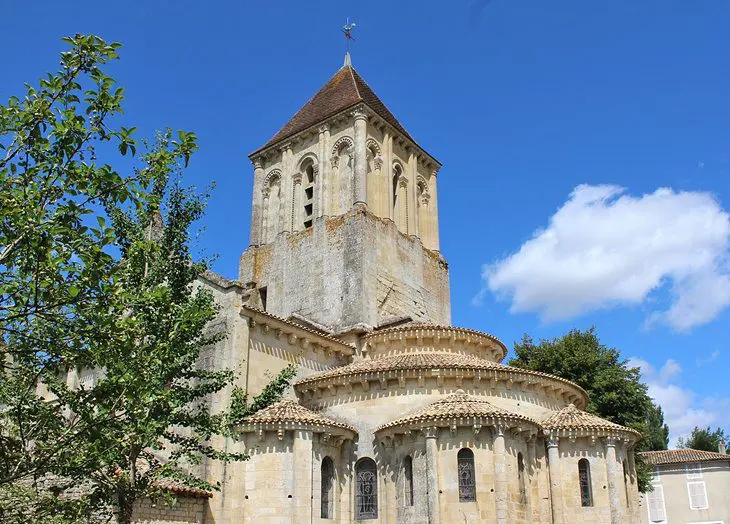
Between Poitiers and La Rochelle, the characteristic medieval hilltop village of Melle is on the “Way of Saint James” pilgrimage route to Santiago de Compostela in Spain. Because of its religious heritage, the village has three noteworthy Romanesque churches built in the 11th and 12th centuries.
The UNESCO-listed Eglise Saint-Hilaire is noteworthy for its radiating chapels of harmonious proportions, as well as its intricately carved capitals that feature plants, monsters, and fantastical beings. The Eglise Saint-Pierre has an inspiring bright, harmonious interior that contrasts its somber exterior.
The Eglise Saint-Savinien is an austere Romanesque church with a simple, almost completely unadorned facade. The church now houses a cultural center and hosts a classical music festival in June, the Festival de Melle.
26. Talmont-sur-Gironde
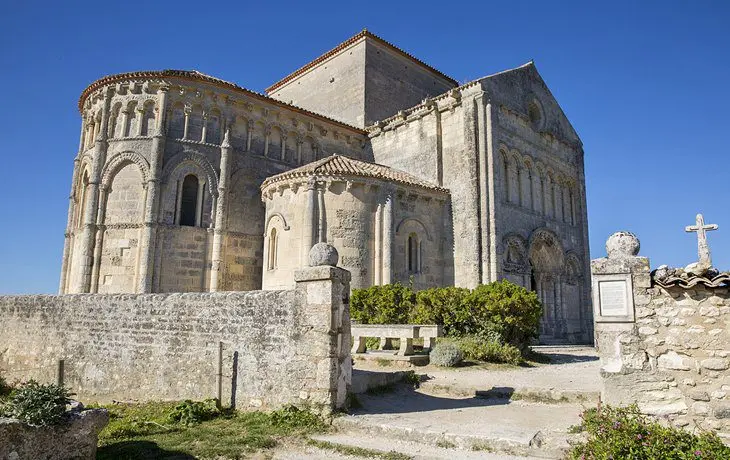
The village of Talmont-sur-Gironde enjoys a majestic setting on a cliff overlooking the Gironde Estuary. One of France’s Plus Beaux Villages, Talmont-sur-Gironde was founded for King Edward I in the 13th century.
The village was designed as a fortified town and is still surrounded by its ancient ramparts. The town has many narrow streets lined with red-tile roofed, whitewashed houses.
The village’s Eglise Sainte-Radegonde is one of the most impressive Romanesque churches in the region. Intricate sculptural details adorn the facade, while a harmonious sense of brightness and spaciousness defines the marvelous interior.
27. Aulnay
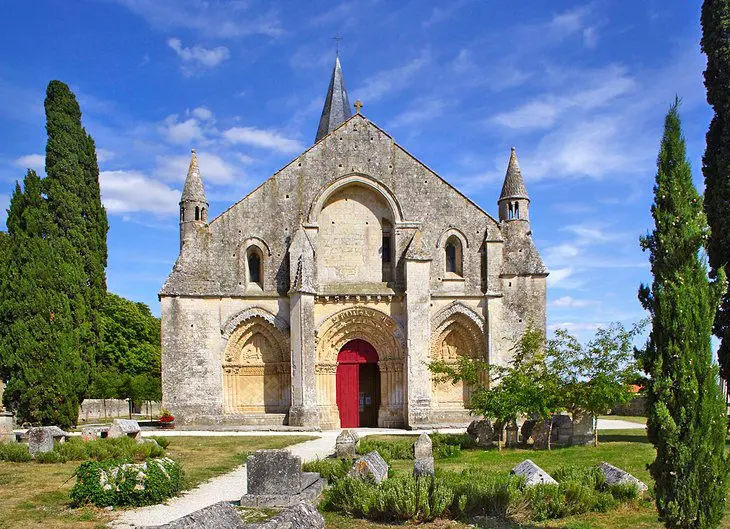
About 40 kilometers from Cognac, the village of Aulnay has a charming Old World atmosphere. Like Aubeterre-sur-Dronne, the town was a stop on the “Way of Saint James” medieval pilgrimage road to Santiago de Compostela in Spain.
The focal point of Aulnay is the 12th-century Eglise Saint-Pierre. This magnificent Romanesque church has an impressive tower and steeple, a richly sculptured facade, and fine capitals.
28. Mornac-sur-Seudre
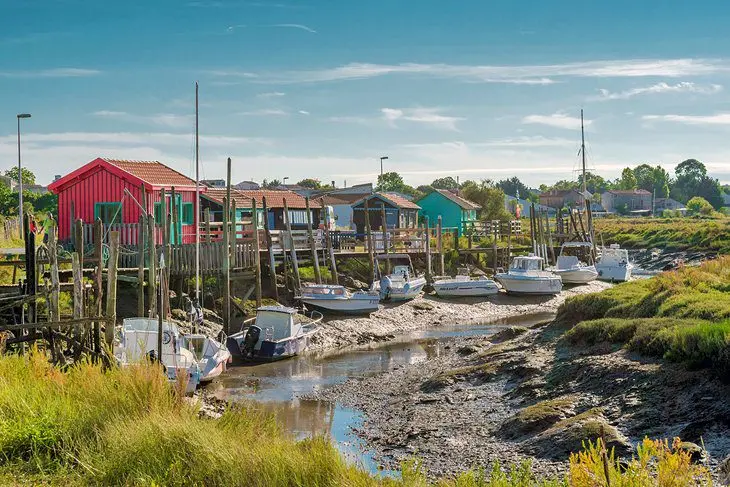
In a peaceful, sheltered marshland environment, Mornac-sur-Seudre is an old fishing village interwoven with canals. Today, the local industry is focused on oyster farms and salt extraction.
The waterfront village is listed as one of France’s Plus Beaux Villages because of its charming old-world ambience. Narrow cobblestone lanes invite visitors to take a leisurely stroll through the town. Typical whitewashed houses feature light blue or green shutters.
A must-see attraction is the Eglise Saint-Pierre, a unique fortified Romanesque church built in the 11th-century.
The village has many seafood restaurants that gourmands will appreciate.
Where to Stay in Poitou-Charentes for Sightseeing
We recommend these charming Poitou-Charentes hotels in the towns of Angoulême, La Rochelle, Royan, and Rochefort-sur-Mer:
- Hotel Saint Gelais : 4-star luxury in Angoulême, stylish contemporary decor, convenient location, quiet country feel, gourmet restaurant.
- Un Hotel en Ville : mid-range hotel in La Rochelle, steps to the waterfront, warm hospitality, delicious breakfast.
- Hotel Residence de Rohan : 3-star Royan boutique hotel, near the beach, friendly staff, heated outdoor pool.
- Ibis Rochefort : budget-friendly 3-star hotel in the center of Rochefort-sur-Mer, modern decor, secure parking.










